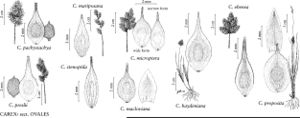Difference between revisions of "Carex mariposana"
Bull. Torrey Bot. Club 43: 619. 1917.
FNA>Volume Importer |
imported>Volume Importer |
||
| (2 intermediate revisions by 2 users not shown) | |||
| Line 6: | Line 6: | ||
|place=43: 619. 1917 | |place=43: 619. 1917 | ||
|year=1917 | |year=1917 | ||
| + | }} | ||
| + | |special_status={{Treatment/ID/Special_status | ||
| + | |code=F | ||
| + | |label=Illustrated | ||
| + | }}{{Treatment/ID/Special_status | ||
| + | |code=E | ||
| + | |label=Endemic | ||
}} | }} | ||
|basionyms= | |basionyms= | ||
| Line 49: | Line 56: | ||
|publication title=Bull. Torrey Bot. Club | |publication title=Bull. Torrey Bot. Club | ||
|publication year=1917 | |publication year=1917 | ||
| − | |special status= | + | |special status=Illustrated;Endemic |
| − | |source xml=https:// | + | |source xml=https://bitbucket.org/aafc-mbb/fna-data-curation/src/2e0870ddd59836b60bcf96646a41e87ea5a5943a/coarse_grained_fna_xml/V23/V23_606.xml |
|genus=Carex | |genus=Carex | ||
|section=Carex sect. Ovales | |section=Carex sect. Ovales | ||
Latest revision as of 20:41, 5 November 2020
Plants densely cespitose. Culms 20–91 cm. Leaves: sheaths adaxially white-hyaline, sometimes gold tinged near summit, summit U-shaped or zigzag to rounded, prolonged to 3 mm beyond collar; distal ligules 1.5–4 mm; blades 3–4 per fertile culm, to 7–30 cm × 1.6–3.9 mm. Inflorescences dense or open, gold to brown, occasionally beaded, 1.7–4.8 cm × 6–16(–23) mm; proximal internode 3.5–7.5 mm; 2d internode 2–5.5 mm, these 2 internodes collectively more than 1/3 as long as inflorescences; proximal bracts usually bristlelike, shorter than inflorescences. Spikes (3–)5–12, distant, loosely aggregated, ovoid to broadly ovoid, 6–14.5 × 2.5–9.2 mm, base rounded to attenuate, apex truncate, rounded, or sometimes tapered. Pistillate scales gold to brown and often reddish, with whitish or green midstripe, ovate to broadly ovate, (2.5–)3.5–4.7 mm, usually shorter than and narrower or as wide as perigynia, margin white, 0–0.2 mm wide, apex obtuse to acuminate. Perigynia ascending, green or straw colored to coppery, conspicuously 6–11-veined abaxially, (0–)4–5(–8)-veined adaxially, veins reaching top of achene, lance-ovate to ovate, plano-convex or biconvex, 3.4–4.8(–5.3) × 1.1–1.6(–2.2) mm, 0.4–0.65 mm thick, margin flat, including wing 0.15–0.4 mm wide, ciliate-serrulate at least on distal body; beak gold to brown, usually reddish, at tip, cylindric, unwinged, ± entire for 0.5–0.6 mm, abaxial suture inconspicuous or with conspicuous white margin, distance from beak tip to achene 1.5–2.5 mm. Achenes elliptic to ovate or, rarely, broadly ovate, 1.5–2 × 0.9–1.3 mm, 0.4–0.6 mm thick.
Phenology: Fruiting summer.
Habitat: Moist mountain meadows and slopes
Elevation: 1200–3200 m
Discussion
Most material from Idaho reported as Carex mariposana is C. abrupta; plants in at least two Idaho localities very closely resemble C. mariposana.
Selected References
None.

